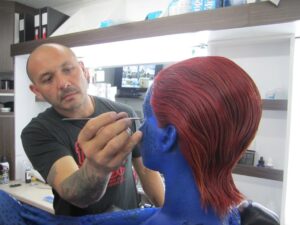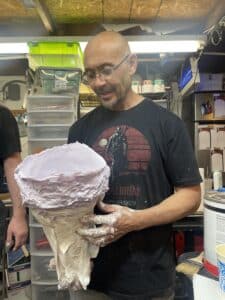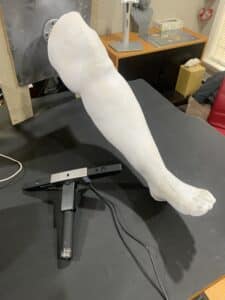By Jewel Connelly, Communications Specialist
 The process of prothesis fabrication is very personal for everyone with preferences varying widely from one person to another. While some are content with the mechanical/robotic look of a prosthetic device, others opt for more customization with artistic covers, and even realistic silicone options that resemble their human limbs. For Danielle Soncasie who has been using a transtibial prosthesis since 1994, she has always dreamed of seeing herself with two matching legs.
The process of prothesis fabrication is very personal for everyone with preferences varying widely from one person to another. While some are content with the mechanical/robotic look of a prosthetic device, others opt for more customization with artistic covers, and even realistic silicone options that resemble their human limbs. For Danielle Soncasie who has been using a transtibial prosthesis since 1994, she has always dreamed of seeing herself with two matching legs.
Danielle was born with a birth defect known as Proximal Femoral Focal Deficiency, when the femur is malformed or missing and causes one leg to be shorter than the other. In her youth, her days were spent in Shriners Hospital for Children, where she underwent more than 40 corrective orthopedic surgeries. Cooped up inside, Danielle amused herself by delving into comic books and immersing herself in sci-fi movies. As an adult, her natural passions even led her to launch her own YouTube channel, Comics and Cosmetics, where the licensed cosmetologist and self-proclaimed registered super-nerd discusses related topics while doing her makeup.

Apart from prosthetic limbs built for the limb loss and limb difference community, prosthetics are widely utilized on sets to bring characters to life on screen. After years of seeing realistic prosthetics and lifelike limbs in movies, Dani began to wonder how the worlds of special effects and functional prosthetics could intersect for a more significant impact on people’s everyday lives. Emmy Award-winning SFX makeup artist and designer Brian Sipe, who has showcased his work in films like Avengers: Endgame and Infinity Wars, Guardians of the Galaxy Vol. 2, X-Men, and The Mandalorian, among others, played a pivotal role in Danielle’s journey. Through their meeting and learning from Brian, she realized that the custom leg she had envisioned was not just a dream but entirely within the realm of possibility. With that, the Belle Jambe Project was born.
This initiative was passionately crafted to ignite interest and bring to fruition the vision of making fully customizable, comfortable, and realistic limbs accessible to people living with limb loss or limb difference. “Amputees shouldn’t have to choose between comfort OR aesthetics. We want to create more options and not just focus on the physical aspect of being an amputee but improving quality of life,” explained Danielle while discussing the impact of prosthetics on self-image, especially for women. By leveraging the resourcefulness and materials from the special effects industry, the project aims to demonstrate that custom mold prosthetics, liners, and sockets can be produced more cost-effectively and affordably.
 Danielle’s friendship with Brian afforded her a unique opportunity to have her leg molded using a 3D scanner as they began the process of creating the first prototype. Stepping into Brian’s workshop, Danielle first had her leg scanned using a Revopoint 3D scanner, the same technology used on actor Mark Hamill for The Mandalorian and The Book of Boba Fett. The next step is where Brian’s expertise in the special effects industry came into play. Brian and his mentees molded both her legs with silicone, as opposed to plaster. Also, the mold was made while she was in a standing position instead of laying down. A plaster jacket was then used over the silicone to keep the mold in place. The goal is to use the silicone mold to craft a prosthetic limb that mirrors her natural legs. For Danielle, the greatest advantage of a silicone liner is its ability to fill in all the spaces where she has scar tissue from her leg lengthening surgery/external fixator.
Danielle’s friendship with Brian afforded her a unique opportunity to have her leg molded using a 3D scanner as they began the process of creating the first prototype. Stepping into Brian’s workshop, Danielle first had her leg scanned using a Revopoint 3D scanner, the same technology used on actor Mark Hamill for The Mandalorian and The Book of Boba Fett. The next step is where Brian’s expertise in the special effects industry came into play. Brian and his mentees molded both her legs with silicone, as opposed to plaster. Also, the mold was made while she was in a standing position instead of laying down. A plaster jacket was then used over the silicone to keep the mold in place. The goal is to use the silicone mold to craft a prosthetic limb that mirrors her natural legs. For Danielle, the greatest advantage of a silicone liner is its ability to fill in all the spaces where she has scar tissue from her leg lengthening surgery/external fixator.
 In addition to completing the first prototype, Danielle and Brian have plans to develop a full-length documentary that will serve as a vehicle and educational tool for the mission of the Belle Jambe Project. Cosmetic prosthetics are generally not covered by insurance, as they are considered ‘not medically necessary.’ However, Dani aims to demonstrate through research the positive impact they can have on the psychological and psychosocial well-being of individuals using prosthetics.
In addition to completing the first prototype, Danielle and Brian have plans to develop a full-length documentary that will serve as a vehicle and educational tool for the mission of the Belle Jambe Project. Cosmetic prosthetics are generally not covered by insurance, as they are considered ‘not medically necessary.’ However, Dani aims to demonstrate through research the positive impact they can have on the psychological and psychosocial well-being of individuals using prosthetics.
If you would like to learn more about the Belle Jambe Project, stay up to date on developments, or donate please visit the webpage. Visit Comics and Cosmetics’ website or subscribe to the YouTube channel (@ComicsandCosmetics). You can also follow Danielle on X (@CosmeticsComics), Facebook, and Instagram (@comics_and_cosmetics).

